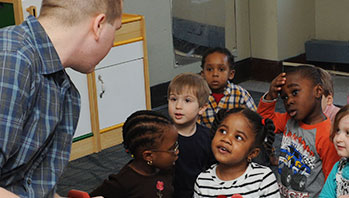- “Colors” chart (from Week 1)
- jars (or clear cups)
- paint (red, white, yellow, black)
- marker
- black
- color
- mix
- paint
- white
MA Standards:
Speaking and Listening/SL.PK.MA.1: Participate in collaborative conversations with diverse partners during daily routines and play.
Language/L.PK.MA.1: Demonstrate use of oral language in informal everyday activities.
Language/L.PK.MA.6: Use words and phrases acquired through conversations, listening to books read aloud, activities, and play.
Head Start Outcomes:
Language Development/Receptive Language: Attends to language during conversations, songs, stories, or other learning experiences.
Language Development/Expressive Language: Uses language to express ideas and needs.
PreK Learning Guidelines:
English Language Arts/Language 2: Participate actively in discussions, listen to the ideas of others, and ask and answer relevant questions.
Talk Together: Mixing Colors

© Commonwealth of Massachusetts, Department of Early Education and Care (Jennifer Waddell photographer). All rights reserved.
STEM Key Concepts: There are many different colors; A color can have many different shades (from very light to very dark); White paint mixed with a color makes a lighter shade of the color; Black paint mixed with a color makes a darker shade of the color; Two or more colors can be combined to make a new color
ELA Focus Skills: Speaking and Listening, Vocabulary
Display jars of different paint colors. Review what children know about mixing colors. Begin by discussing what happens when you mix the colors white and black into other colors.
- Hold up a jar of red paint and a jar of white paint. Ask, What do you think will happen when you mix these two colors together? (the red gets lighter)
- Hold up the jar of yellow paint and the jar of black paint. Ask, What do you think will happen when you mix these two colors together? (the yellow gets darker)
Now hold up the jar of red paint and the jar of yellow paint. Say, I wonder what will happen if you mix these two colors together? Record children’s ideas on the “Colors” chart under a new subheading, “Mixing Colors.” Continue to discuss what happens when colors are mixed to make new colors.
Social Emotional Tip: Asking children to state their ideas and preferences helps build their ability to recognize and express their own thoughts, ideas, and opinions.
